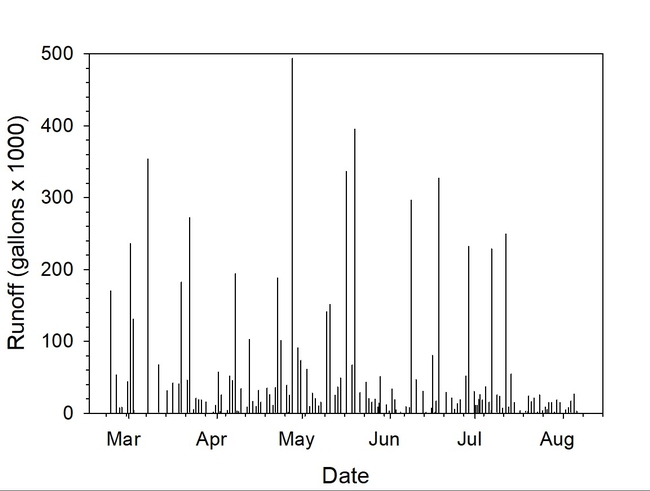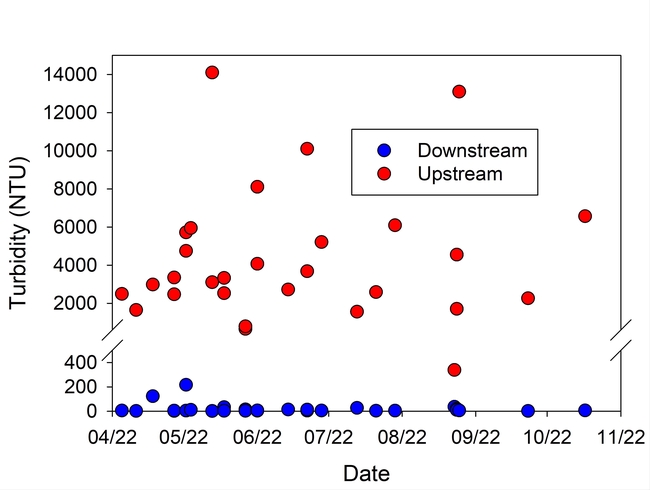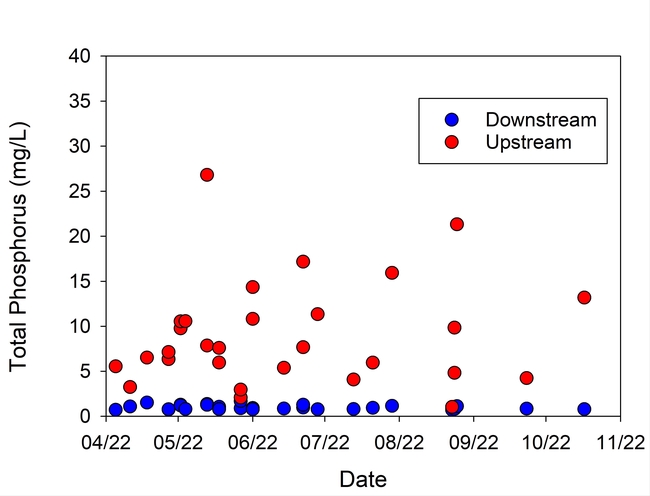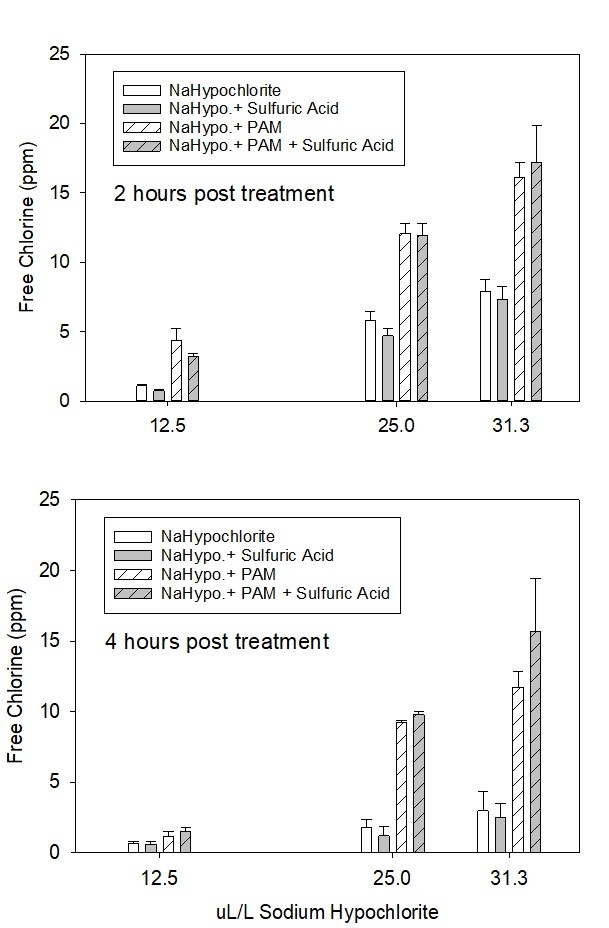Minimizing suspended sediments in irrigation runoff is desirable for several reasons. For growers reusing tailwater for watering their crops, they must assure that the water has minimal food safety risks by testing it for generic E coli and/or treating it with chlorine. The concentration of free (or reactive) chlorine is reduced when tailwater contains a high concentration of suspended sediments. Treating a large volume of tailwater with chlorine can be a significant expense over a season so it is important to be able to remove as much of the suspended sediments as possible before treatment.
A second reason is that water quality regulations under Agriculture discharge Order 4.0 requires tailwater discharged into public water ways to not be toxic to aquatic organisms. Pesticides that strongly bind to soil, such as pyrethroids, are carried on the suspended sediments in runoff which can cause toxicity to aquatic organisms that live in creeks and rivers downstream from farms. Also, particulate forms of N and P which bind with the suspended sediments pose a water quality risk to receiving waterbodies such as the sloughs and wetlands along the coast. Both nutrients can spur algal blooms which reduces dissolved oxygen available to fish and other aquatic organisms.
In a previous article we discussed a new approach to using Polyacrylamide (PAM), an inexpensive polymer molecule for reducing soil erosion, to treat sprinkler water. This practice uses a specialized applicator (Fig. 1) to condition water flowing from a well with PAM. An advantage of this method is that the cartridges in the applicator release a small amount of PAM (1 to 2 ppm) into the irrigation water, which flocculates soil particles that could potentially become suspended and transported in runoff. Field tests using a prototype version of this applicator resulted in about 90% less suspended sediment in the tailwater when treated with PAM compared to untreated irrigation water.
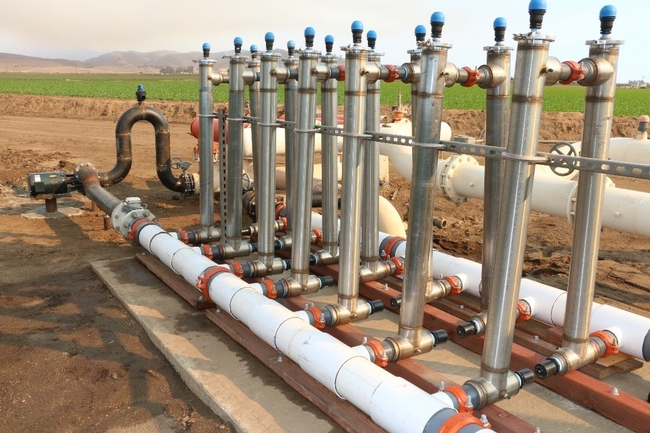
Auger ditch applicator
A second approach we developed for reducing suspended sediment in runoff is to use a smart applicator that can automatically apply dry PAM to the runoff water flowing in farm ditches. This type of applicator is suspended on a platform above a ditch and uses a hopper filled with dry PAM and an auger system controlled by an electric motor and small computer to drop PAM down a tube into the flowing runoff (Fig. 2). A weir and float mechanism located upstream are used to monitor the flow rate of the runoff so that the computer can adjust the frequency that PAM is applied. A video at this link demonstrates how the auger applicator operates.
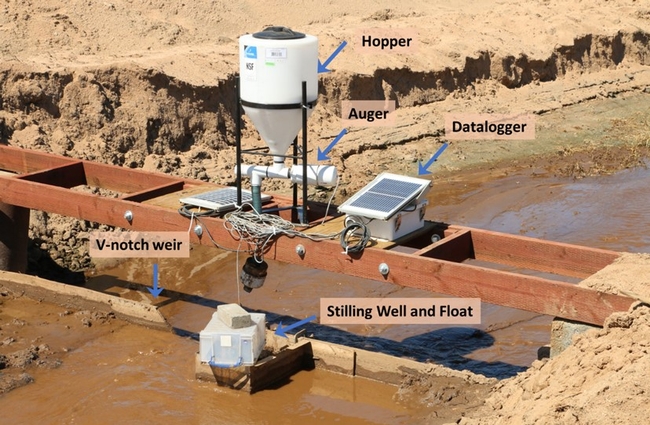
Field testing of the ditch applicator
A yearlong study at a commercial farm showed that the ditch applicator was effective in removing 98% of the suspended sediments transported in runoff (Table 1, Fig. 3). Based on the total runoff measured in a single drainage ditch during the 2022 season (21.5 acre-feet), an estimated 106 tons of sediment were removed (Fig. 4).
Turbidity in the runoff was reduced by more than 99%, and Total P and N were reduced on average by 89% and 60%, respectively, during the season (Table 1, Figs. 5 and 6). These reductions in nutrient load, suspended sediment, and turbidity could greatly improve water quality in water bodies downstream from farms that discharge irrigation runoff.
Table 1. Average concentration of N, P, and sediments carried in irrigation runoff before (upstream) and after (downstream) treatment with the PAM ditch applicator (April – October 2022). Average of 32 paired grab samples from 3 farm ditches. Downstream locations varied from 300 to 500 ft downstream from the PAM applicators.
Ditch applicator vs well applicator
Although more effective at reducing suspended sediment in runoff than the well applicator, the ditch applicator required more maintenance. PAM needed to be added to the hopper once or twice per week during the irrigation season, and sediment that settled in the ditches had to be cleaned out periodically using a backhoe. Also, removed sediment had to be spread back in the fields. The well applicator only required periodic refilling of the cartridges with PAM, and minimizes the amount of sediment that settles out in the drainage ditches.
PAM effects on chlorine requirement
To evaluate the effect of PAM on the quantity of chlorine needed to treat runoff, we performed a laboratory assay on samples of sprinkler runoff collected upstream and downstream of one of the ditch applicators. The turbidity of the upstream (untreated) and downstream samples (PAM treated) was 2276 and 9.5 NTU, respectively. The electrical conductivity of the runoff samples was 1.35 dS/m and the pH was 8.4 before adding chlorine. The main factors evaluated in the assay were sodium hypochlorite concentration and acidification with 10% sulfuric acid. Presumably, acidifying the runoff to a pH of 6.5 should increase the concentration of the more reactive form of chlorine, hypochlorous acid which is more effective as a microbial disinfectant. Residual free chlorine concentration of the treatments was evaluated 2 and 4 hours after adding 12.5% sodium hypochlorite at concentrations ranging 12.5 to 31.3 ul per liter of runoff (100 to 250 ul of 12.5% NaOCl per L of water).
The laboratory assay showed that reducing suspended sediment concentration using PAM increased the efficacy of chlorine treatment of runoff. The free chlorine concentration for PAM treated runoff was more than twice the concentration measured in the untreated runoff for all sodium hypochlorite concentrations evaluated after 2 hours and more than three times the concentration after 4 hours (Fig. 7). Free chlorine concentration in the PAM treated runoff was more than 2.5 ppm two hours after treatment at the lowest concentration of chlorine evaluated (12.5 ul/L) but was less than 0.5 ppm in the untreated runoff. To attain similar chlorine efficacy as PAM treated runoff, untreated runoff would require twice as much sodium hypochlorite (25 ul/L). These chlorine requirements would correspond to 26 and52 gallons of 12.5% sodium hypochlorite to treat and acre-foot of runoff with and without a PAM pretreatment, respectively.
Acidification of the runoff to a pH of 6.5 with sulfuric acid increased the free chlorine concentration in the PAM treated runoff at the highest concentration of sodium hypochlorite (31.3 ul/L) after 4 hours. Acidification did not have a significant effect on free chlorine concentration for the other treatments.
Summary
Both versions of the dry PAM applicators (well and ditch) show promise for greatly reducing soil erosion, as well as helping improve water quality and the efficacy of chlorine for treating tail water reused for irrigation. By considerably reducing the concentration of suspended sediment in irrigation runoff, chlorine can be more effective as a disinfection agent, and better control E. coli and other microbial pathogens that could potentially cause public health risks.
Acknowledgments: We greatly appreciate assistance in fabricating the prototype PAM applicators from RayFab. This project was funded by the California Leafy Green Research Board.
Further reading


